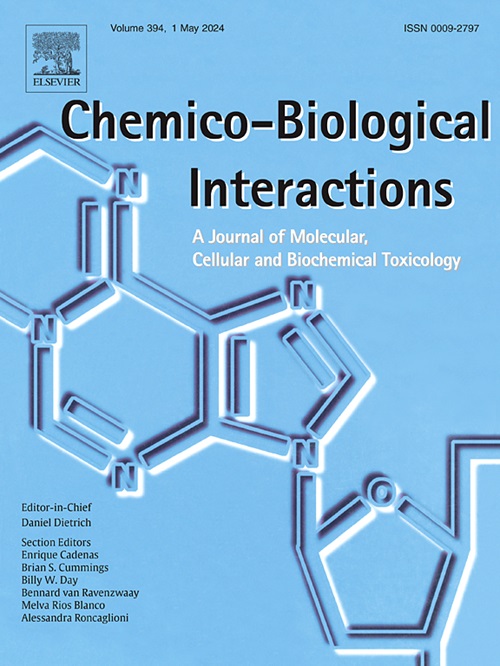萝卜硫素处理HL-60细胞可防止氯氮平毒性和蛋白质共价结合:对氯氮平诱导的粒细胞缺乏症的影响。
IF 4.7
2区 医学
Q1 BIOCHEMISTRY & MOLECULAR BIOLOGY
引用次数: 0
摘要
氯氮平是治疗难治性精神分裂症患者的关键药物。然而,氯氮平目前被认为处方不足,因为它有特殊药物不良反应的风险,包括严重的中性粒细胞减少症(粒细胞缺乏症)。据报道,氯氮平治疗的粒细胞缺乏症患者出现野生型NRH:醌氧化还原酶2 (NQO2)的频率较低,而突变型NQO2 (NQO2-1541- aa)的频率较高。萝卜硫素是一种众所周知的诱导剂,可诱导相关酶异构体NQO1的表达,具有保护作用;然而,萝卜硫素在调节NQO2表达中的作用尚不清楚,并且萝卜硫素通过NQO1和NQO2激活介导的氯氮平毒性保护仍未研究。我们假设萝卜硫素可以诱导NQO1和NQO2表达,并且萝卜硫素介导的NQO1和NQO2激活对氯氮平诱导的毒性具有保护作用。测定萝卜硫素和氯氮平HL-60的细胞活力,选择合适的处理浓度。免疫印迹法检测NQO1和NQO2蛋白表达及对氯氮平蛋白结合的保护作用。采用微滴板检测谷胱甘肽(GSH), LCMS检测氯氮平代谢产物,紫外-可见分光光度法检测髓过氧化物酶活性。萝卜硫素(1 ~ 10 μM)显著诱导NQO1和NQO2蛋白表达。氯氮平的LC5024h存活率约为50 μM,萝卜硫素的LC5024h存活率不低于5 μM。萝卜硫素(2.5 ~ 5 μM)可防止氯氮平引起的细胞活力下降。氯氮平- n -氧化物(一种活性较低的代谢物)的形成在萝卜硫素预处理组比未处理组增加。此外,在萝卜硫素(2.5 - 10 μM)的作用下,细胞内髓过氧化物酶活性显著增加。萝卜硫素预处理组大鼠GSH水平显著升高,氯氮平共价蛋白结合明显减弱。总之,结果表明,萝卜硫素预处理HL-60细胞对氯氮平的反应性代谢物具有显著的防御作用。诱导NQO2是新颖的,需要进一步的研究来具体证明它是如何提供保护的。萝卜硫素诱导的谷胱甘肽增加与氯氮平- n -氧化物形成增强的结合似乎有助于降低共价蛋白结合,这与氯氮平诱导的细胞活力下降和髓过氧化物酶活性增加有关。本文章由计算机程序翻译,如有差异,请以英文原文为准。
Sulforaphane treatment of HL-60 cells protects against clozapine toxicity and protein covalent binding: implications for clozapine-induced agranulocytosis
Clozapine is a critical drug for treatment-resistant schizophrenia patients. However, clozapine is currently considered under-prescribed as it carries a risk of idiosyncratic adverse drug reactions, including severe neutropenia (agranulocytosis). Some stuides reported that clozapine-treated patients that exhibited agranulocytosis had a lower frequency of wild-type NRH: Quinone Oxidoreductase 2 (NQO2) and a higher frequency of mutant NQO2 (NQO2-1541-AA). Sulforaphane is a well-known inducer for the expression of a related enzyme isoform, NQO1, that has protective effects; however, sulforaphane's role in modulating NQO2 expression is unknown, and sulforaphane-mediated protection via NQO1 and NQO2 activation against clozapine toxicity remains uninvestigated. We hypothesized that sulforaphane can induce NQO1 and NQO2 expression, and sulforaphane-mediated NQO1 & NQO2 activation play a protective role against clozapine-induced toxicity.
Sulforaphane and clozapine HL-60 cell viability were determined to select appropriate treatment concentrations. Immunoblotting was used to investigate NQO1 and NQO2 protein expression and protection against clozapine-protein binding. Glutathione (GSH) was analyzed by microtiter plates, LCMS was used to quantify clozapine metabolites, and UV–Vis spectrophotometry was used to determine myeloperoxidase activity.
Sulforaphane (1–10 μM) significantly induced NQO1 and NQO2 protein expression. Clozapine's LC5024h for viability was approximately 50 μM, and sulforaphane did not decrease viability up to 5 μM. Sulforaphane (2.5–5 μM) prevented the clozapine-induced decrease in viability. The formation of clozapine-N-oxide, a less reactive metabolite, was increased in sulforaphane pre-treated groups than in untreated groups. Also, intracellular myeloperoxidase activity increased significantly in the presence of sulforaphane (2.5–10 μM). GSH levels were significantly higher in sulforaphane pre-treated groups, and clozapine covalent protein binding was significantly attenuated by the pre-treatment of sulforaphane.
Collectively, the results suggest that sulforaphane pre-treatment of HL-60 cells provides significant defenses against the reactive metabolites of clozapine. The induction of NQO2 is novel and requires further studies to demonstrate specifically how it is involved. Sulforaphane-induced increases in GSH in combination with enhanced clozapine-N-oxide formation appear to contribute to decreasing covalent protein binding, which is correlated with clozapine-induced decreases in cell viability and increased myeloperoxidase activity.
求助全文
通过发布文献求助,成功后即可免费获取论文全文。
去求助
来源期刊
CiteScore
7.70
自引率
3.90%
发文量
410
审稿时长
36 days
期刊介绍:
Chemico-Biological Interactions publishes research reports and review articles that examine the molecular, cellular, and/or biochemical basis of toxicologically relevant outcomes. Special emphasis is placed on toxicological mechanisms associated with interactions between chemicals and biological systems. Outcomes may include all traditional endpoints caused by synthetic or naturally occurring chemicals, both in vivo and in vitro. Endpoints of interest include, but are not limited to carcinogenesis, mutagenesis, respiratory toxicology, neurotoxicology, reproductive and developmental toxicology, and immunotoxicology.

 求助内容:
求助内容: 应助结果提醒方式:
应助结果提醒方式:


